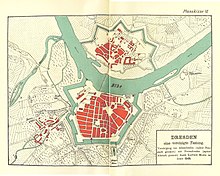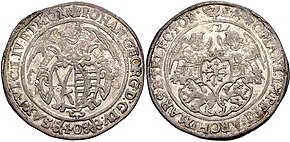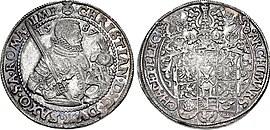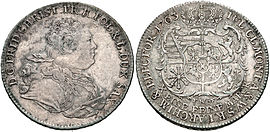Dresden Mint
The Dresden mint, established by Elector August 1556, became the only mint in the Electorate of Saxony after all of the state mints had been confiscated . It existed until 1887. It can thus be assigned to the third major period in Saxon coin history .
history
A Nicolaus quondam magister monetae is mentioned in Dresden as early as 1311 , but without reference to a mint. A mint in Dresden at the Kreuzkirche is first attested in 1414 in a deed of donation. It reports on "a donation from a master Franz von Dippoldiswalde for an altar in the Holy Cross Chapel, which is located in a house behind the Holy Cross near the mint". Medieval coins from a Margrave-Meissnian mint in Dresden are still not known.
Establishment of the mint under Elector August


Elector August (1553-1586) submitted to the secretly initiated by him checking the coins in mints Freiberg , Annaberg and Schneeberg found that the mint master the fine silver content of Guldengroschen ( Taler had) arbitrarily reduced. According to the Saxon coinage system from 1549 ( coin base from 1549 to 1558), the fineness of the guldengroschen was 14 Lot 8 Grän (= 902.78 / 1000). The size of the reduction in the silver content was not known. The elector then had all state coins closed and transferred them to a single coin in Dresden, in the immediate vicinity of his residence palace , in order to be able to better monitor the correctness of the shot and grain . The Freiberg mint, which was relocated to Dresden in 1556, had been the main Saxon mint since the 13th century. The Annaberg mint was first moved back to the local monastery in 1557 , before it was also merged with the Dresden mint in 1558. The Schneeberg mint was in operation until 1571, as evidenced by the Schneeberg mint mark T. The mint in Zwickau had been closed since 1534 and that in Buchholz since 1553. The elector had the Leipzig mint shut down for a long time in 1571. This means that the Dresden Mint has been the only mint in the Electorate of Saxony for almost 100 years.
The Erbstein brothers report on the staff of the Dresdner Münze, during the time when Elector August reorganized the coinage system as part of his comprehensive reforms:
"Mint masters under Elector August were [...] in Dresden, where, as noted above, a new mint building was built in 1556 [...]: Hans Biener (Büner) from Joachimsthal , who (perhaps identical to the Annaberg citizen of the same name occurring in 1543 ) 1553 mentioned as an assistant to mint master Andreas Alnpeck in Freiberg and came to Dresden with the relocation of the local mint in 1556. Here he was first appointed as administrator of the mint on October 3, 1556, when he received a new appointment on July 9, 1558. He later had the title of mint master, and as such he worked until the quarter of Luciae 1604. He died in 1604. His mark HB can be found for the first time in 1557 and still on coins from 1605 […]. As Wardein and sworn Probirer in the Mint of Dresden, Caspar Hase was appointed at the same time as Biener (October 3, 1556), who had previously been named Wardein zu Freiberg (since 1547) and was still in charge of his Dresden office in 1582, while Johann was here at that time Ludewig Frank as a master coin smith, Kilian Prager as an iron cutter ( coin engraver ) and Matthes Urban as a coin printer. "
The wardein had to check the fineness of the metal delivered for minting and the coins minted from it and was the mint master's assistant and deputy. The 10 imperial circles in which the Holy Roman Empire of the German Nation was divided were responsible for monitoring compliance with the imperial coinage system, which Elector August 1571 had joined. The Imperial Coin Order prescribed a general award for each imperial circle . In the Upper Saxon Empire , to which mainly Saxony , Thuringia and Brandenburg belonged, the Electoral Saxon mint master usually held the position of Generalwardein.
In addition to coin production, the Dresden Mint developed into an important center for the art of medals.
Tipper and luffing time

During the time of money falsification, the tipper and wipper era , the monopoly of the Dresden mint was broken with the establishment of tipper mints . Examples of this are the mints of Annaberg , Grünthal , Leipzig , Langensalza , Sangerhausen and Zwickau .
The Dresden mint master Heinrich von Rehnen initially refused to issue falsified coins and did not give up his mint master's mark until he was released from his service, which had been dropped from the Upper Saxon district . The tipper coins minted in Dresden from 1620 to 1623 are Dreier, Schreckenberger , Groschen, 2-, 5-, 8-, 10-, 20-, 30-, 40- and 60-Groschen items ( Kippertaler to 60 Groschen) with the mint master's mark swan and flying swan.
Later coin turmoil led to the brief operation of the Bautzen mint in 1666 for the minting of land coins for Upper Lusatia and in 1669 to the re-establishment of the Leipzig mint, which was in operation with interruptions until 1765.
Establishment of a secondary mint
From 1804 the entire copper coinage for Saxony took place in the Grünthal mint , which was located in the "Althammer" of the Saigerhütte Grünthal and, as a secondary mint to the Dresden mint, minted Heller , Pfennige, Dreier and 4-Pfennig pieces until 1825. After the introduction of ring minting , the production of copper coins had to be moved back to Dresden, as the technical prerequisites for minting in the ring were missing in Grünthal.
Relocation within Dresden
In 1738, the construction of the Catholic Court Church between the Elbe bridge and the palace required the demolition of the old coin building next to the Elbe Gate. The new mint started operating as early as 1737. It was located behind the Frauenkirche and the churchyard "between the Große Fischer- and Salzgasse in house no. 633 (after abolition of the consecutive numbering: at the Frauenkirche 10), a three-story building in the immediate vicinity of the casemates , today's Brühlschen Terrasse . "
The coin behind the Frauenkirche is described in August Schumanns Staatslexikon 1815:
“The coin, the mint. This building, located behind the Frauenkirche, borders the building yard just described and was built in 1738. [...] Even now the Dresden Mint is the only one in the country and supplies all types of coins made of silver. The copper ones are minted in the Saigerhütte Grünthal . The so-called silver wagon brings the silver won in the Ore Mountains to Dresden every 14 days. [...] Both the melting of the silver and the minting of the same take place in the coin itself, but the stretching and cutting of the plates in the silver hammer at the Zwinger Bridge [...]. The stretching and cutting machines were increased and improved by the master builder Baldauf from Freiberg . [...] The coin is particularly worth seeing because of the ingeniously laid out horse work , on which 4 horses pull and stretch the teeth and plates when there is a lack of water . "
In 1872 the Dresden Mint began to be minted on behalf of the Reich . At the same time, the mint mark for the coins of the Kingdom of Saxony was replaced by the mint mark E. With the issuance of the new Mark coins in gold and silver ended the Saxon coinage , when coins were minted continue in Saxony. The mint existed until 1887.
Relocation to Muldenhütten
In 1876, coinage had reached its peak. The coin operation then began to slow down. Many workers had to be laid off.
The last coins were minted on February 5, 1887 and were pfennigs. Two days later, mint master Buschick had 25 one-pfennig pieces minted from the year 1887 with a large point after the word PFENNIG as a mark of identification for the “very last one-penny”. The demolition of the mint and neighboring houses created the building site for the Royal Saxon Art Academy , which was built by Constantin Lipsius until 1894 and is now the seat of the Dresden Academy of Fine Arts . The new Muldenhütten mint started operations as early as 1887 and continued its operations until 1953.
The coins of the mint
Saxon coin footer 1549–1558 / 1558–1571
From 1549 to 1558, according to the Saxon coinage system, the fine mark was struck at 8.86 gulden groschen and from 1558 to 1571 at 9.93 gulden groschen.
From its founding until the introduction of the Imperial Coin Regulations in the Electorate of Saxony in 1571 , the Dresden Mint has included pfennigs , threes, groschen , pointed groschen , Schreckenberger 1 ⁄ 8 -, 1 ⁄ 4 -, 1 ⁄ 2 thaler, thaler (guldengroschen), gold gulden and Double gold guilders minted.
- Taler coins according to the Saxon standard 1558–1571
Elector August, thaler (Guldengroschen) 1567, on the capture of Gotha
Reichsmünzfuß 1571–1667
After Saxony acceded to the imperial coinage system up to the introduction of the Zinnaic coin footer in 1667, the coin minted almost all of the aforementioned denominations except for Spitzgroschen and Schreckenberger. In addition there were Heller , Kreuzer , 1 ⁄ 48 -, 1 ⁄ 24 -, 1 1 ⁄ 2 -, 2, 3 and 4 thalers and the gold coins 1 ⁄ 2 ducats , ducats, 2 ducats, 4 ducats.
The gold coins that continued to be minted after the Electorate of Saxony joined the Reich Coin Order do not belong to the Saxon denominations of the Reich Coin Order. The golden imperial guilder worth 21 groschen from 1584 is a distinctive bill coin.
The kipper coins minted from 1620 to 1623 were land coins that did not have to comply with the Reich coinage system, which was actually the case.
- Taler coins according to the Reichsmünzfuß:
Elector Christian I , Reichstaler 1587
Dreibrüdertaler 1610, Elector Cristian II with his brothers
Elector Johann Georg I , triple thaler 1626
Elector Johann Georg II., Erbländischer Taler ( Broad Taler , Reichstaler) 1662
Zinnaischer Münzfuß and Leipziger Münzfuß 1667–1690 / 1690–1763
From 1667 the coin was minted according to the Zinnaischen and from 1690 according to the Leipziger Fuß . The minting of the species Reichstaler continued according to the Reich coinage system.
From 1667 until the introduction of the convention foot in 1763, the aforementioned denominations were minted and additionally 1 ⁄ 12 thalers, 1 ⁄ 6 thalers (= 15 kreuzers), 1 ⁄ 3 thalers (= 8 groschen), 2 ⁄ 3 thalers (gulden) , Speciesreichstaler, 1 ⁄ 4 -, 1 1 ⁄ 2 -, 3 and 5 ducats.
Two taler terms emerged: the Kuranttaler or Taler courant at 24 Groschen and the Speciesreichstaler or Reichstaler in specie at 28 Groschen and from 1690 at 32 Groschen. The thaler at 24 groschen was retained as Kuranttaler without being issued. The thaler, also known as the count thaler, was only a unit of account. A few commemorative coins were the exception in Saxony.
- Taler coins after the introduction of the Zinnaic foot and the Leipzig foot, Speciesreichstaler still after the imperial foot:
Elector Johann Georg II., Total thaler (Speciesreichstaler) 1676 (total thaler see Erbländischer Taler )
Elector Johann Georg II., Kuranttaler 1678, Garter Thaler (the Kuranttaler were minted only in exceptional cases)
Elector Friedrich August I. (August the Strong), 2 ⁄ 3 Kuranttaler (Gulden) 1696
King August III. (Elector Friedrich August II.), Speciesreichstaler 1752
Interchangeable thaler foot 1670/71
In the years 1670/1671, exchange thalers and their parts were struck in the exchange thaler foot (see also the article " Wechseltaler ").
Convention base 1763–1838
After the introduction of the convention foot, the coin minted 1 ⁄ 48 -, 1 ⁄ 24 -, 1 ⁄ 12 -, 1 ⁄ 6 -, 1 ⁄ 3 -, 2 ⁄ 3 thalers and convention special thalers from 1763 to 1838 . Gold coins are ducats, 5 and 10 thalers . Other coins are heller, pfennig, 3, 4 and 8 pfennig. The following was counted in the convention cure: the thaler (Reichstaler) as an invoice coin for 24 good groschen , which was not minted .
If one assumes that the first Saxon coins, the medieval high-rimmed pennies , received their domed rim in use and not in a mint, the first rim design on the outer rim of silver coins took place in 1763. The flans for the production of thalers and silver guilders had a border ornament, a so-called leaf border, for the first time before embossing.
- Talers according to the convention footing (1763–1838):
Elector Friedrich Christian , Convention special thaler 1763
Administrator Franz Xaver , Convention special thaler 1764
14 thalers foot 1839–1856
After the Kingdom of Saxony became part of the Dresden Coin Convention in 1838 and the introduction of the 14 thaler foot , pfennigs, 2 and 3 pfennigs, 1 ⁄ 2 new pennies, new penny, 2 new penny , 1 ⁄ 6 thaler, 1 ⁄ 3 thaler, thaler (Vereinstaler) and double thaler minted. Gold coins are 2 1 ⁄ 2 , 5 and 10 thalers .
The club thaler was divided into 30 new pennies = 300 pfennigs.
A new penny (abbreviation Ngr.) Is a Saxon divisional coin minted from 1841 to 1873 with the inscription "Neugroschen".
30 thalers foot 1857–1871 (1872)

On 24 January 1857, the agreed Zollverein States with Austria and Liechtenstein a common Vereinstaler issue. The customs find of 500 g was introduced, from which 30 club thalers were minted. Until the introduction of the imperial currency, coinage was based on this standard.
Pfennigs, 2- and 5 pfennigs, Neugroschen, 2 Neugroschen, 1 ⁄ 6 Taler, 1 ⁄ 3 Taler, Taler (Vereinstaler) and double thaler were minted. Gold coins are 1 ⁄ 2 and 1 crown .
With the introduction of the imperial currency , all denominations in the Dresden mint were minted on behalf of the empire in accordance with the Reich Coin Act of December 4, 1871 and July 9, 1873.
On behalf of other German countries
From 1826, the mint temporarily minted coins on behalf of other German states:
- For the Duchy of Saxe-Coburg and Gotha from 1826 to 1827 without Mmz., After the closure of the Gotha Mint in 1838 from 1841 to 1872 with Mmz. G, F, B and Mzz. E.
- 1841–1869 for the Duchy of Saxony-Altenburg , Mmz. G, F, B
- 1872 for the Grand Duchy of Mecklenburg-Schwerin , Mmz. B.
- 1872 for the Grand Duchy of Mecklenburg-Strelitz , Mmz. B.
Vicariate coins
Vicariate coins are those coins that were struck during the execution of the imperial throne by the Electors of Saxony for North and the Electors of the Palatinate for South Germany as representatives ( vicars ) of the Emperor and made this recognizable through pictures and writing.
Saxon vicariate coins were minted from 1612 to 1792 in eight vicariate cases in different denominations from the vicariate groschen to the thaler and double thaler and gold coins to the multiple ducat. They usually show the elector on horseback and the explanatory inscription or the empty emperor's throne or the imperial eagle with the Saxon heart shield. In addition, the title of the Imperial Vicar is given as PROVISOR ET VICARIUS or similar. All of Saxony's vicariate coins with mint master's mark were minted in the Dresden mint. Ducats from 1711 to the Vicariate of August the Strong without a mintmaster's mark could also come from the Leipzig mint.
Mint master of the Dresden Mint
| Mint master | from | to | Mintmaster's mark | comment |
|---|---|---|---|---|
| Hans Biener | 1556 | 1604 | HB, even without | from 1556 administrator, later mint master, from 1557 and 1605 also with HB († 1604) |
| Heinrich von Rehnen | 1605 | 1624 | HR, standing swan, swan flying up | from 1558 to 1603 as a mint master in the Brandenburg service |
| Hans Jakob | 1624 | 1635 | HI, crossed hooks | |
| Cornelius Mende | 1635 | CM | ||
| Sebald Dirleber | 1635 | 1640 | SD | from St. Joachimsthal, kaiserl. Münzwart zu Prague, then Electoral Saxon. Mint master |
| Constantin Rothe | 1640 | 1678 | CR, acorn on the branch | In 1668 the stamps of the Bautzen Mint for Upper Lusatia were also minted |
| Christoph Fischer | 1678 | 1686 | CF, two fish with their backs turned against each other | 1655–1668 Electoral Saxon. and herzogl. Saxon-Weimar. General aradein; Grandson of Christoph Preuße |
| without mint master | 1686 | 1688 | without mintmaster mark | Supply by the coin writer and successor |
| Johann Koch | 1688 | 1698 | IK, crossed arrows | |
| Johann Lorenz Holland | 1698 | 1716 | ILH, Zainhaken | |
| Johann Georg Schomburg | 1716 | 1734 | IGS | buried on October 9, 1745 in Dresden |
| Friedrich Wilhelm ô Feral | 1734 | 1756 | FW ô F | born around 1705, buried on February 5, 1764 in Dresden. Brother-in-law of Johann Georg Schomburg. |
| Johann David Billert | 1756 | 1757 | IDB, B, even without | under Prussian administration |
| Friedrich Wilhelm ô Feral | 1757 | 1763 | FW ô F, ô F, even without | born around 1705, buried on February 5, 1764 in Dresden. Brother-in-law of Johann Georg Schomburg. |
| Ernst Dietrich Croll | 1763 | 1778 | EDC, EC | 1753–1763 also Leipzig mint |
| Johann Ernst Croll | 1779 | 1804 | IEC, IC, C | |
| Samuel Gottlieb Helbig | 1804 | 1813 | SGH, H | |
| Johann Gotthelf Studer | 1812 | 1832 | IGS, GS, S | 1816 Introduction of ring stamping for thalers |
| Johann Georg Grohmann | 1833 | 1844 | G | from March 29, 1832 to August 24, 1833 still with mint master's mark S |
| Gustav Theodor Fischer | 1845 | 1860 | F. | from 1859 ring coinage for all denominations |
| Gustav Julius Buschick | 1860 | 1887 | B. | Mintmark E since 1872 , moved to Muldenhütten in 1887 |
Coin engravers of the Dresden Mint (incomplete)



The coin engravers were also active as medalists . Your signatures can be important for the chronological classification of undated medals.
Medalists who were not active as coin engravers are not included here.
| Coin engravers | from | to | Life dates | signature | comment |
|---|---|---|---|---|---|
| Kilian Prager the Elder | Mentioned in 1582 | ||||
| Wendel under the linden tree | 1585 | 1592 | |||
| Kilian Prager the Younger | 1592 | after 1601 | |||
| Tobias Wolf (also Wolff) | before 1586 | after 1601 | TW (monogram) | ||
| Heinrich von Rehnen | 1605 | 1624 | † 1633 | HVR | was a mint master, coin engraver and medalist |
| Herbart of Lünen (Lynen) | around 1605 | around 1626 | HVL, HVLF (fecit) | worked under Heinrich von Rehnen | |
| Ruprecht Niclas Kitzkatz | 1616 | 1633 | NCR, monogram | ||
| Paul Walter (Walther) | 1633 | 1654 | PW | ||
| Johann Caspar Höckner | 1654 | 1671 | * 1629, † 1671 | IC. H. (IC as monogram), H. | |
| Ernst Caspar Dürr | 1671 | 1681 | ECD | DO if Dürr and Omeis work together | |
| Martin Heinrich Omeis | 1671 | 1703 | * 1650, † 1703 | O. f. (fecit), MHO, OM, monogram | DO if Dürr and Omeis work together |
| Pieler | around 1681 | ||||
| Johann Wilhelm Höckner | 1702 | 1749 | HOECKNER | ||
| Johann Friedrich Stieler | 1756 | 1790 | * 1729, † 1790 | St, S for Leipzig | |
| Carl Christian Pribus | before 1763 | 1787 | † 1787 | P for Leipzig | |
| Friedrich Heinrich Kruger | 1787 | 1805 | * 1749, † 1815 | FH KRÜGER | |
| Christian Joseph Kruger | 1790 | 1814 | * 1759, † 1814 | KR. | |
| Johann Veit Stadelmann | (1814) 1817 | 1824 | |||
| Karl (Carl) Reinhard Kruger | (1814) 1817 | 1857 | * 1794, † 1874 | CR KRÜGER, KRÜGER, RK | |
| Friedrich Anton König | 1824 | 1844 | * 1794, † 1844 | ||
| Karl Christian Friedrich Ulbricht | (1846) 1848 | 1860 | |||
| Ernst Wilhelm Ulbricht | (1857) 1861 | 1864 | |||
| Alois Stanger | 1864 | 1868 | * 1836, † 1870 | ||
| Max Barduleck | (1865) 1871 | 1911 | * 1846, † 1923 | M. BARDULECK, MB | From 1865 to 1870 as an assistant, from 1886 for Muldenhütten |
literature
- Walther Haupt : Sächsische Münzkunde , Berlin 1974
- Max Barduleck: The last years of the mint in Dresden , list of works 1865 to 1911, published by Paul Arnold, Berlin 1981
- Paul Arnold, Harald Küthmann, Dirk Steinhilber: LARGE GERMAN COIN CATALOG FROM 1800 TO TODAY , Augsburg 2010
- Paul Arnold: Elector August (1553–1586) and the Saxon coinage . In Numismatic Issues No. 20, Dresden 1986
- Lienhard Buck: The coins of the Electorate of Saxony 1763 to 1806 , Berlin 1981
- Julius Erbstein , Albert Erbstein : Discussions in the field of the Saxon coin and medal history when listing the Hofrath Engelhardt'schen collection , Dresden 1888
- Rudolf Lorenz: The coins of the Kingdom of Saxony 1806–1871 and the Grand Duchy of Warsaw 1807–1815 , Berlin 1968
- Georg Kaspar Nagler : The monogramists. Hirth, Munich 1919.
Individual evidence
- ^ Max Barduleck: The last years of the mint in Dresden , list of works 1865 to 1911, published by Paul Arnold, Berlin 1981, p. 18.
- ↑ Julius and Albert Erbstein: Discussions in the field of the Saxon coin and medal history with the listing of Hofrath Engelhardt's collection , Dresden 1888.
- ^ Lienhard Buck: The coins of the Electorate of Saxony 1763 to 1806 , Berlin 1981, p. 48
- ^ Paul Arnold: Elector August (1553–1586) and the Saxon coinage . In Numismatic Booklet No. 20, Dresden 1986, p. 12.
- ^ Lienhard Buck: The coins of the Electorate of Saxony 1763 to 1806 , Berlin 1981, p. 50
- ↑ Dresden . In: August Schumann : Complete State, Post and Newspaper Lexicon of Saxony. 2nd volume. Schumann, Zwickau 1815, p. 101.
- ↑ coinarchives: 1 Pfennig 1887 E with a large point after PFENNIG
- ^ Paul Arnold, Harald Küthmann, Dirk Steinhilber: Large German coin catalog from 1800 to today. Augsburg 1997, p. 186, p. 195, p. 297
- ^ Friedrich von Schrötter, N. Bauer, K. Regling, A. Suhle, R. Vasmer , J. Wilcke: Dictionary of Coin Studies , Berlin 1970 (reprint of the original edition from 1930).
Web links
- acsearch Friedrich August I. 1806–1827. Bronze medal 1813 (CR Krüger). The Augustus Bridge in Dresden was blown up on March 19. View of the blown bridge from Brühl's terrace / eight lines of writing.


















